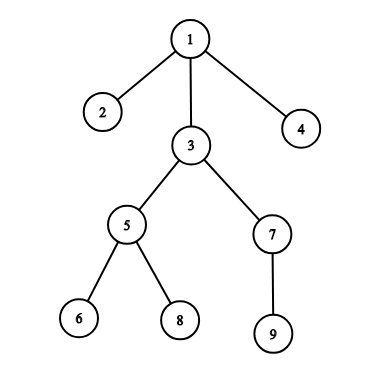time limit per test
3 seconds
memory limit per test
256 megabytes
input
standard input
output
standard output
In this problem you will have to help Berland army with organizing their command delivery system.
There are nn officers in Berland army. The first officer is the commander of the army, and he does not have any superiors. Every other officer has exactly one direct superior. If officer aa is the direct superior of officer bb, then we also can say that officer bb is a direct subordinate of officer aa.
Officer xx is considered to be a subordinate (direct or indirect) of officer yy if one of the following conditions holds:
- officer yy is the direct superior of officer xx;
- the direct superior of officer xx is a subordinate of officer yy.
For example, on the picture below the subordinates of the officer 33 are: 5,6,7,8,95,6,7,8,9.
The structure of Berland army is organized in such a way that every officer, except for the commander, is a subordinate of the commander of the army.
Formally, let's represent Berland army as a tree consisting of nn vertices, in which vertex uu corresponds to officer uu. The parent of vertex uucorresponds to the direct superior of officer uu. The root (which has index 11) corresponds to the commander of the army.
Berland War Ministry has ordered you to give answers on qq queries, the ii-th query is given as (ui,ki)(ui,ki), where uiui is some officer, and kiki is a positive integer.
To process the ii-th query imagine how a command from uiui spreads to the subordinates of uiui. Typical DFS (depth first search) algorithm is used here.
Suppose the current officer is aa and he spreads a command. Officer aa chooses bb — one of his direct subordinates (i.e. a child in the tree) who has not received this command yet. If there are many such direct subordinates, then aa chooses the one having minimal index. Officer aa gives a command to officer bb. Afterwards, bb uses exactly the same algorithm to spread the command to its subtree. After bb finishes spreading the command, officer aa chooses the next direct subordinate again (using the same strategy). When officer aa cannot choose any direct subordinate who still hasn't received this command, officer aa finishes spreading the command.
Let's look at the following example:

If officer 11 spreads a command, officers receive it in the following order: [1,2,3,5,6,8,7,9,4][1,2,3,5,6,8,7,9,4].
If officer 33 spreads a command, officers receive it in the following order: [3,5,6,8,7,9][3,5,6,8,7,9].
If officer 77 spreads a command, officers receive it in the following order: [7,9][7,9].
If officer 99 spreads a command, officers receive it in the following order: [9][9].
To answer the ii-th query (ui,ki)(ui,ki), construct a sequence which describes the order in which officers will receive the command if the uiui-th officer spreads it. Return the kiki-th element of the constructed list or -1 if there are fewer than kiki elements in it.
You should process queries independently. A query doesn't affect the following queries.
Input
The first line of the input contains two integers nn and qq (2≤n≤2⋅105,1≤q≤2⋅1052≤n≤2⋅105,1≤q≤2⋅105) — the number of officers in Berland army and the number of queries.
The second line of the input contains n−1n−1 integers p2,p3,…,pnp2,p3,…,pn (1≤pi<i1≤pi<i), where pipi is the index of the direct superior of the officer having the index ii. The commander has index 11 and doesn't have any superiors.
The next qq lines describe the queries. The ii-th query is given as a pair (ui,kiui,ki) (1≤ui,ki≤n1≤ui,ki≤n), where uiui is the index of the officer which starts spreading a command, and kiki is the index of the required officer in the command spreading sequence.
Output
Print qq numbers, where the ii-th number is the officer at the position kiki in the list which describes the order in which officers will receive the command if it starts spreading from officer uiui. Print "-1" if the number of officers which receive the command is less than kiki.
You should process queries independently. They do not affect each other.
题意呢 就是给出n,m,共n个点[1,n],m次询问。第二行给出n-1个数a[i],2<=i<=n;a[i]表示i的父亲节点是a[i]。
按照题目给的图树形结构,每次询问,让求从q点,搜k次后搜到的是哪个点,这样的点不存在时输出-1。
1,首先点数太多,用vector存图。
2.用常规深搜,需要搜m次,m较大会超时。需要优化求解方法。
#include<bits/stdc++.h>
using namespace std;
const int maxn=2e5+10;
int n,m,q,k;
vector<int >g[maxn];
int cnt=1;
int s[maxn];
int r[maxn];
int t[maxn];
int ans=-1;
void dfs(int st)
{
r[cnt]=st;//搜cnt次找到了st
t[st]=cnt++;// 找到st搜了cnt次
for(int i=0;i<g[st].size();i++)
dfs(g[st][i]);
s[st]=cnt;//再回溯回来到st点时经过的点的个数。
}
int main()
{
scanf("%d%d",&n,&m);
for(int i=2;i<=n;i++)
{
int a;
scanf("%d",&a);
g[a].push_back(i);
}
dfs(1);
while(m--)
{
cnt=-1;
scanf("%d%d",&q,&k);
if(k<=s[q]-t[q])//能判断q一家共有多少人,保证以q为根搜k次后的数值存在。
cnt=r[t[q]+k-1];
printf("%d\n",cnt);
}
}
























 367
367

 被折叠的 条评论
为什么被折叠?
被折叠的 条评论
为什么被折叠?








